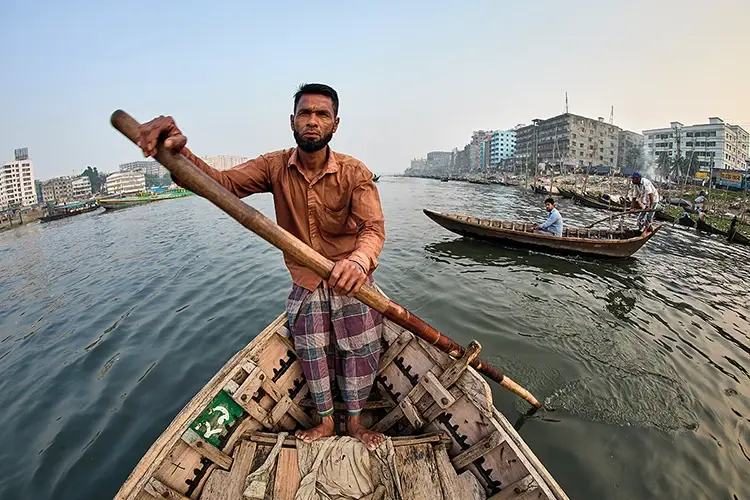
Can Bangladesh’s new government save the rivers on which the country depends?
Words and photographs by
You can smell the river even before you can see it – a noxious odour that burns the nose and the back of the throat. ‘Ten to 15 years ago, this area was lightly populated, and the river was clean. People fished here and children played in the water,’ says Rashedul Haque as he stares down at inky-black stagnant water that’s filled with plastic rubbish and hemmed in by half-finished buildings. ‘But,’ he continues, ‘today, nothing lives in the water and nobody swims here.’
As we talk, a group of people in Wellington boots and green T-shirts emblazoned with the words BD Clean gathers on the far bank. Slipping on surgical gloves and face masks, and life jackets for the weaker swimmers, they slither down the riverbank and enter the tar-like water. Rashedul and I watch as they start tearing out handfuls of invasive water hyacinth and filling sacks with discarded plastic bags, water bottles and other rubbish. Some of the braver – or perhaps more foolhardy – ones dunk themselves completely into the water, emerging from the depths with car tyres, hunks of metal and, in one case, a police riot shield and a crate of unused petrol bombs, both reminders of the recent political upheaval in Bangladesh.
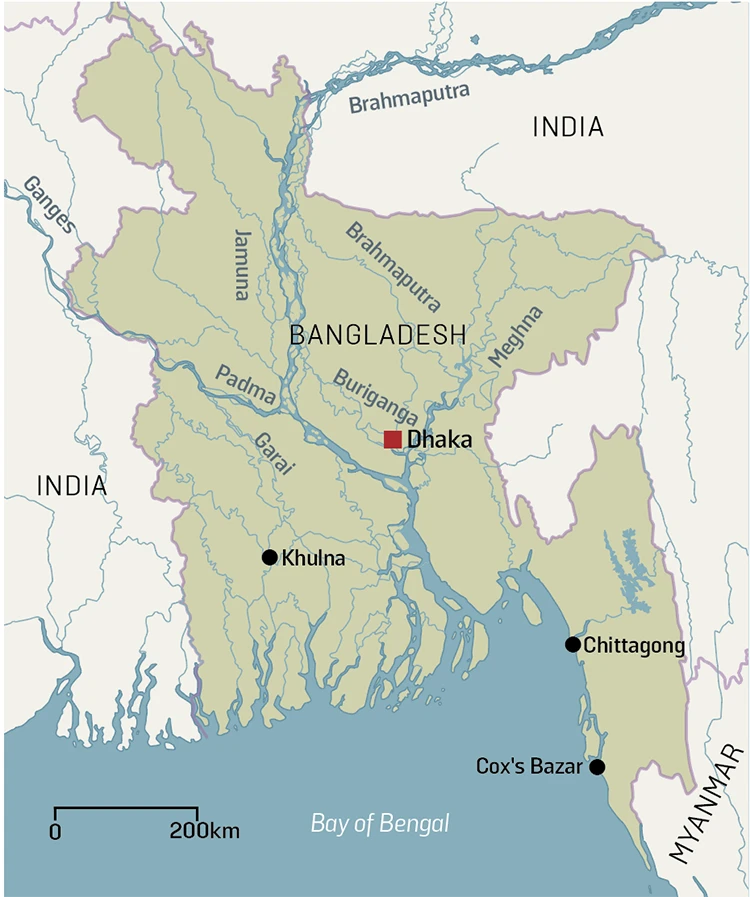

Much of this country, which is home to around 173 million people squeezed into an area of land roughly the same size as England, forms a part of the huge Ganges Delta. Floodplains cover around 80 per cent of Bangladesh, and hundreds of rivers – from the mighty Ganges (known here as the Padma) and Brahmaputra to far smaller waterways – snake across the country. With rivers being one of the defining features of Bangladesh, it doesn’t come as a surprise to hear that they’re economically and socially vital for the nation. The agriculture sector, which employs around 48 per cent of the workforce, is dominated by rice paddy farming and fish farming, both of which are reliant on fresh, clean water.
But it’s not just the farmers who need the rivers. With only 15 per cent of the population having access to piped water, most Bangladeshis need rivers, ponds and other water sources for drinking, cooking and washing. In a country so laced with waterways, the rivers also act like roads, and water transport – for goods and materials in particular – is an important part of Bangladeshi life.
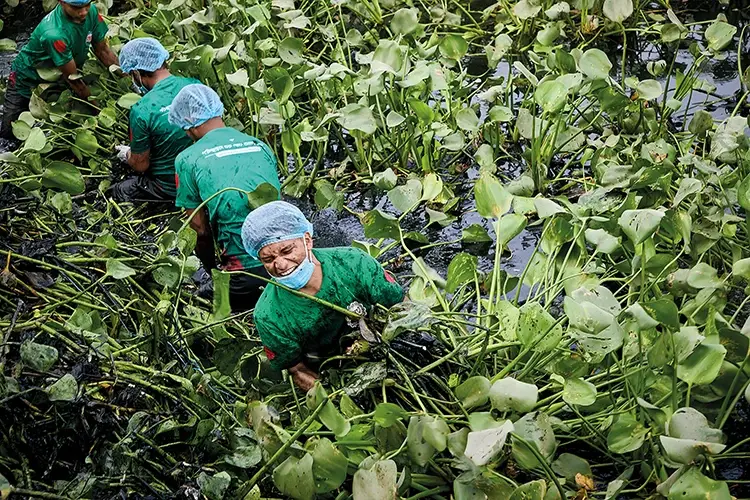

Just how important rivers are to Bangladesh became clear to me when I first laid eyes on the vast Buriganga River. Running calmly through the centre of Dhaka, the broiling capital, this river (which, despite its size, is a mere tributary of the Padma) is the heart and soul of Bangladesh. From Sadarghat, the main riverside dock in the old quarter of Dhaka, it appeared that all life was focused on the river. A thousand wobbly rowing boats acted as water taxis, ferrying people up and down the river. Enormous barges lumbered downstream so overloaded with sand and building materials that there was barely a centimetre of clearance above the water. Worn-out houseboats, occupied by a dozen families at a time, were pulled up onto the grimy riverbanks next to rusting cargo ships, and above it all, towered multi-hulled ferries waiting to ferry thousands of passengers to far away river towns. Aside from a few children with bamboo spears, the one thing there wasn’t much sign of was fishing. And there’s a good reason for that. The Buriganga, like the other four major rivers and 200 canals that course through Dhaka, is almost biologically dead.
A biologically dead river is a river that has ceased to perform its ecological functions and is no longer capable of sustaining life. It takes a lot to kill a river, but for decades, the waterways of Dhaka have been assaulted from all sides. According to a 2021 report for the World Economic Forum, the devastation to Dhaka’s waterways omes from several directions, including untreated sewage, industrial runoff and structures encroaching into and blocking the rivers.
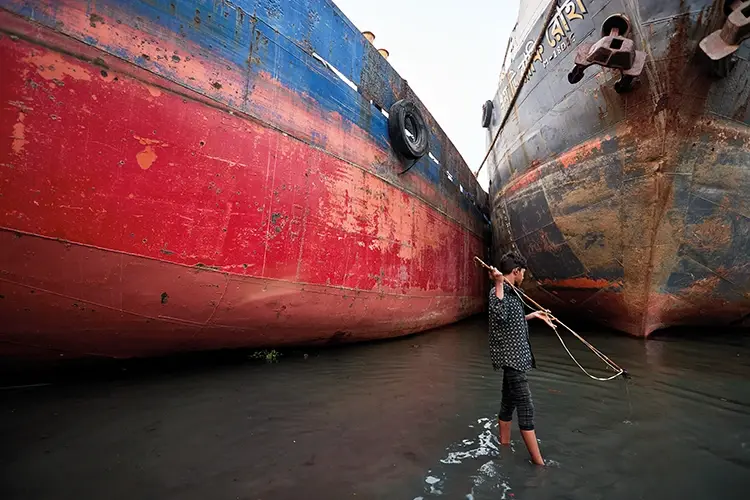

Zooming in on the details, the same report goes on to highlight that the sewage network of Dhaka – a city with an estimated 21 million inhabitants – covers only 20 per cent of the population, meaning unimaginable amounts of untreated municipal wastewater discharged straight into Dhaka’s water bodies. In addition, toxic liquid waste, and even infectious biomedical waste from hospitals, laboratories and other healthcare facilities, are often just poured straight into drains and sewage systems, from where they flow into the rivers. Another report, this time by the World Health Organization, stated that an astonishing 60,000 cubic metres of toxic waste finds its way into the Buriganga every day. A 2022 report by Bangladeshi NGO the Environment and Social Development Organisation (ESDO), claimed that 73,000 tonnes of plastic waste is carried down Bangladeshi rivers and out into the sea every year, while another report states that Bangladeshis as a whole use an incomprehensible 45.55 billion polythene bags a year; most of which are thrown away after having been used just once.
As bad as all that sounds, however, perhaps the most significant reason for the deplorable state of the Buriganga and other waterways in Dhaka is the world’s insatiable demand for cheap, fast-fashion clothing. Bangladesh is one of the world’s leading manufacturers of fast-fashion clothing that fills high-street chains across the world. There’s no denying that the industry, which by 2024 was worth US$44 billion a year to Bangladesh and accounted for 80 per cent of its annual export earnings, has created a huge number of jobs in Bangladesh. The textile industry has helped elevate the country from one f the poorest in the world to one of the fastest-growing lower-middle-income economies. But the goose that laid the fashionista egg comes with a downside. A report by the European Environment Agency states that around 3,500 substances are used in textile production. Of these, 750 are hazardous for human health and 440 damage the environment. A 2024 report co-published by the International Pollutants Elimination Network (IPEN) and ESDO showed that the Bangladeshi textile industry is a significant source of PFAS water pollution. PFAS, which are also known as ‘forever chemicals’, are toxic and virtually indestructible substances, some of which can cause serious illnesses, including various cancers. In many of the samples taken for the study, PFAS levels were far above regulatory limits set in the EU and the USA, and several samples contained globally banned chemicals.
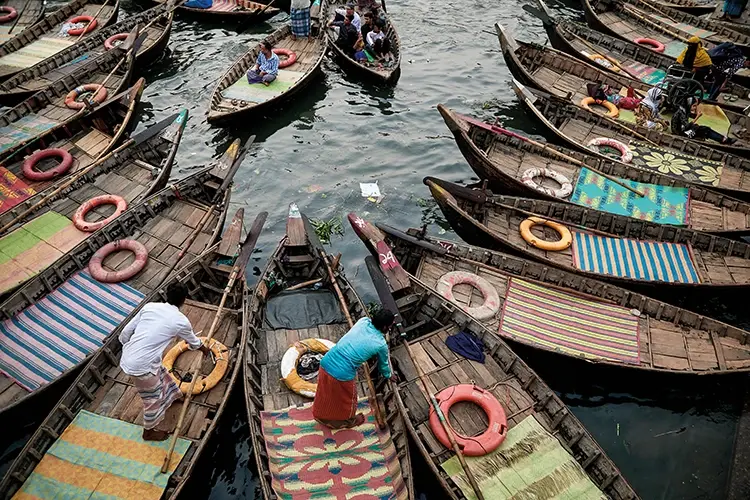

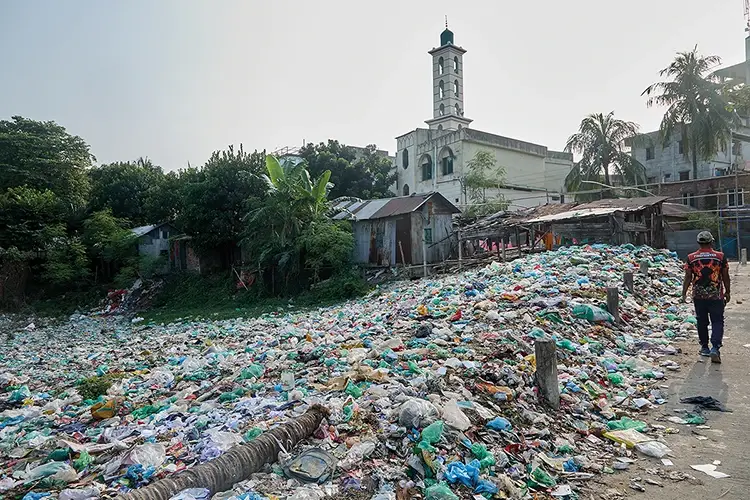

On paper, at least, Bangladesh has anti-pollution laws that should keep pollution to a minimum. For instance, all textile factories should have an effluent treatment plant (ETP) that treats and cleans industrial wastewater so that it can be safely returned to streams and rivers. However, these machines are expensive to buy and costly to run. Corruption at all levels of society has long been widespread in Bangladesh (in 2024, the Corruption Perceptions Index placed Bangladesh at 151st out of 180 countries – with 180 being the most corrupt). This means that by paying off corrupt politicians and law enforcement officials, factory owners can easily ignore environmental regulations relating to the disposal of industrial wastewater. Even when a factory does have an ETP, it’s often alleged that it’s only turned on for short periods of time, or when there’s an inspection taking place. The remainder of the time, the toxic wastewater is just pumped straight into the waterways that lead to the Buriganga and other rivers.
Not everyone can be bought off, however. In towns and cities across Bangladesh, dedicated and determined non-governmental action groups have sprung up with the aim of tackling water pollution. BD Clean is one such group. Down on the riverbank, Ira is busy cleaning the black sludge off her Wellington boots. ‘I’ve been a member of BD Clean since 2019,’ she says. ‘The first clean-up operation I did was to clean a canal that ran through a busy market. It was filthy! And the first time I got in the water I was really scared about the pollution and the risks. But, everyone else was doing it so I had to as well!’ Smiling at the memory, she goes on to tell me of the poorest in the world to one of the fastest-growing lower-middle-income economies. But the goose that laid the fashionista egg comes with a downside. A report by the European Environment Agency states that around 3,500 substances are used in textile production. Of these, 750 are hazardous for human health and 440 damage the environment. A 2024 report co-published by the International Pollutants Elimination Network (IPEN) and ESDO showed that the Bangladeshi textile industry is a significant source of PFAS water pollution. PFAS, which are also known as ‘forever chemicals’, are toxic and virtually indestructible substances, some of which can cause serious illnesses, including various cancers. In many of the samples taken for the study, PFAS levels were far above regulatory limits set in the EU and the USA, and several samples contained globally banned chemicals.
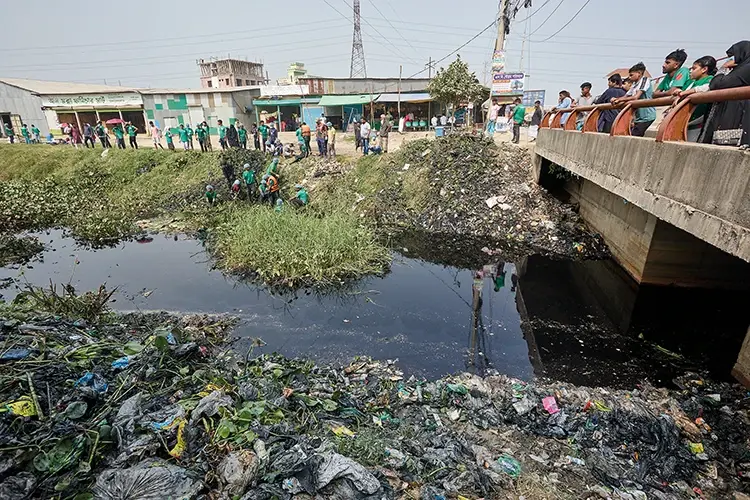

On paper, at least, Bangladesh has anti-pollution laws that should keep pollution to a minimum. For instance, all textile factories should have an effluent treatment plant (ETP) that treats and cleans industrial wastewater so that it can be safely returned to streams and rivers. However, these machines are expensive to buy and costly to run. Corruption at all levels of society has long been widespread in Bangladesh (in 2024, the Corruption Perceptions Index placed Bangladesh at 151st out of 180 countries – with 180 being the most corrupt). This means that by paying off corrupt politicians and law enforcement officials, factory owners can easily ignore environmental regulations relating to the disposal of industrial wastewater. Even when a factory does have an ETP, it’s often alleged that it’s only turned on for short periods of time, or when there’s an inspection taking place. The remainder of the time, the toxic wastewater is just pumped straight into the waterways that lead to the Buriganga and other rivers.
Not everyone can be bought off, however. In towns and cities across Bangladesh, dedicated and determined non-governmental action groups have sprung up with the aim of tackling water pollution. BD Clean is one such group. Down on the riverbank, Ira is busy cleaning the black sludge off her Wellington boots. ‘I’ve been a member of BD Clean since 2019,’ she says. ‘The first clean-up operation I did was to clean a canal that ran through a busy market. It was filthy! And the first time I got in the water I was really scared about the pollution and the risks. But, everyone else was doing it so I had to as well!’ Smiling at the memory, she goes on to tell me hat she’s a botany student, but that she funds her studies by working in the textile industry. ‘I work for [a factory producing clothing for] Primark. They have an ETP, but they don’t use it all the time. Most of the pollution in these rivers comes from the garment industry. This doesn’t make me feel good, so I joined BD Clean so that I could help clean up the rivers and canals. I hope that this makes up for the bad of the work I do at the factory.’ Listening in on our conversation is firefighter and fellow BD Clean volunteer Faisal Ahmed. ‘Primark and the other big companies insist that they are not polluting the waters, but when representatives from these companies aren’t watching, the factories turn off the ETPs and just dump the waste into the rivers.’


When we put these allegations to Primark it had the following to say: ‘At Primark, we’re committed to reducing our impact on the environment, both through our own operations and those of the Primark-approved factories in our supply chain. We work closely with our suppliers to drive compliance with our environmental standards and investigate every issue brought to our attention. This includes through our local teams working in many of our sourcing markets, including Bangladesh.’
Jahirul Islam Robi, the chief coordinator of BD Clean, agrees with Ira and Faisal that the textile industry has been a major contributor to water pollution, but he goes on to say that we all have a part to play. ‘It’s easy to simply put all the blame on industry. But really, the main problem is just a lack of public awareness. Everything gets thrown into the rivers here. From discarded tea leaves and plastic cups right up to industrial pollution. If the person throwing something into the water can’t see it anymore, then for them, it’s gone and is no longer a problem. We need to change this mentality if we are really going to make our rivers clean.’


Despite the apparent impossibility of the situation, change is underway, and for the first time, people like Robi, Rashedul, Ira and Faisal have a little optimism. And it all started in a rather unexpected way. In June 2024, the Supreme Court of Bangladesh reinstated a quota system for government jobs. The impact of this was far greater and more wide-ranging than anyone could have envisioned. Fearing that merit would no longer be enough to secure a coveted government job, thousands of students quickly poured onto the streets in protest.
When the government tried to repress the protests with violence, it only caused the protests to grow in scale. Non-students joined in, and major riots broke out. Soon, people were calling for nothing less than the overthrow of the government and the end of 15 years of corrupt rule by Sheikh Hasina. By August 2024, the situation had become untenable, the government collapsed, and Hasina and her family fled to India.
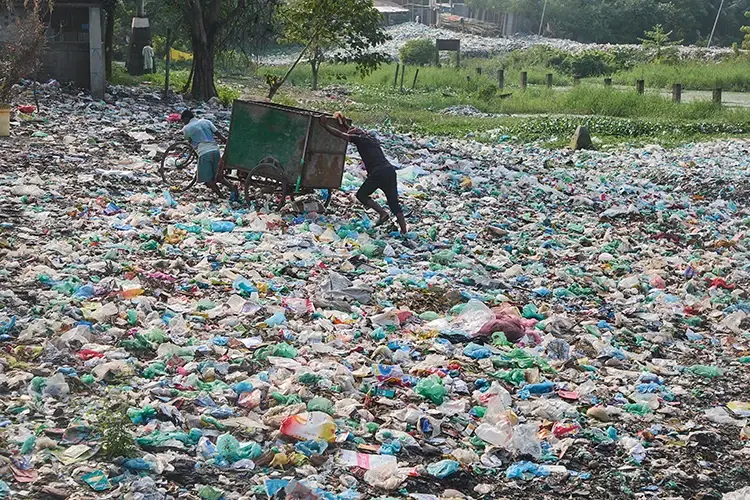

This paved the way for an interim government led by economist and Nobel Peace Prize winner Muhammad Yunus. One of his government’s key aims is to rid the country of the corruption that has plagued Bangladesh for decades. There’s still a long way to go, but, for the first time, there’s hope for the future. To emphasis this, Shabid Zaman from ESDOS told me via telephone that ‘the new government is putting in place some good initiatives to reduce water pollution and there’s been a notable reduction in corruption and the disregard of environmental laws. The new government is also working on the plastic issue. A ban is being put in place on the use of polythene bags, for example.’ When I ask him if all the textile factories are now using ETPs he simply replies, ‘ETPs are not widely used.’ When I ask him if the factories making clothes for the big international brands were using ETPs, his response is diplomatic, ‘I’m not fully updated on this.’ Even so, Zaman sees reason to be optimistic. ‘In ten years, I think things will have improved a lot. Public awareness of water pollution is improving slowly. There are many small-scale projects underway to clean up Dhaka, and now that the politicians are helping, I’m much more hopeful for the future.’
Related articles…
It’s a sentiment that Jahirul from BD Clean echoes, ‘Since the change of government, more young people have got involved with BD Clean and other groups. I think that after the revolution young people realised that they could make a difference. They had a choice, and they could make big changes.’
Peering down at the water, he says, ‘In another 20 years, we will have created a clean and stable Bangladesh. Our goal is to make Bangladesh the cleanest country in the world.’ As he speaks there’s a flash of silver in the water and ripples from a passing fish fan out across the turbid waters of the Buriganga. The river is not yet dead.


EPILOGUE
Shortly after this article was researched, the interim Bangladeshi government shut down the factory that Ira had been working at. We were unable to get confirmation as to why this action had been taken.

